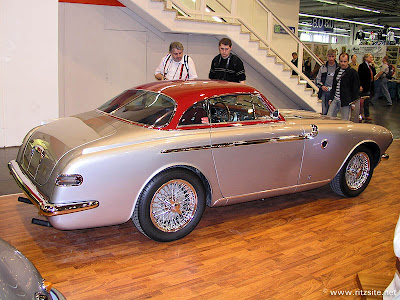FIAT has produced only one V-8 engine (under the FIAT brand) in it's entire 100+ year history. Initially intended for a stillborn post-war flagship luxury sedan, the diminutive 2.0 liter V-8 featured 70-degree architecture, formed from two FIAT V-4s with dual Carter carbs perched atop.
This gem of a V-8 put out 110 hp @ 5600rpm -respectable for two liters in 1952- and seemed perfectly suited to a new FIAT sports car: one that could whip the big boys -Ferrari, Maserati, and Lancia- on what they thought was their 2.0L sports-car racing turf...
This gem of a V-8 put out 110 hp @ 5600rpm -respectable for two liters in 1952- and seemed perfectly suited to a new FIAT sports car: one that could whip the big boys -Ferrari, Maserati, and Lancia- on what they thought was their 2.0L sports-car racing turf...
Thus was born the 1952-55 FIAT 8V, or Otto Vu -meaning
"eight vee" in Italian. Legend has it that FIAT management mistakenly assumed that the nameplate "V-8" had been copyrighted by Ford for the Model A (in reality, Uncle Henry
never bothered).
FIAT built 200 engines for the (very) limited production run, yet only 114 FIAT 8V chassis were actually completed from 1952-54 (company management more focused on high-volume opportunities) with some coachwork at Carozzeria Speciale FIAT, Zagato, Ghia, and Vignale to be finished as 1955 models. Many of these were sold stateside, thus their presence at various concours events in the US today.
By 1953 FIAT was selling surplus engines to Siata of Turin- a major supplier for the FIAT 8V- who produced the Siata 208S ('2.0 L - 8 cyl- Sport"). But while far from a commercial success, the 8V did succeed in FIAT's primary goal of kicking butt at the race track- FIAT 8Vs dominated Italy's popular 2.0L sports-car racing throughout the 1950s, and those were the days when winning meant showroom traffic.
"eight vee" in Italian. Legend has it that FIAT management mistakenly assumed that the nameplate "V-8" had been copyrighted by Ford for the Model A (in reality, Uncle Henry
never bothered).
FIAT built 200 engines for the (very) limited production run, yet only 114 FIAT 8V chassis were actually completed from 1952-54 (company management more focused on high-volume opportunities) with some coachwork at Carozzeria Speciale FIAT, Zagato, Ghia, and Vignale to be finished as 1955 models. Many of these were sold stateside, thus their presence at various concours events in the US today.
By 1953 FIAT was selling surplus engines to Siata of Turin- a major supplier for the FIAT 8V- who produced the Siata 208S ('2.0 L - 8 cyl- Sport"). But while far from a commercial success, the 8V did succeed in FIAT's primary goal of kicking butt at the race track- FIAT 8Vs dominated Italy's popular 2.0L sports-car racing throughout the 1950s, and those were the days when winning meant showroom traffic.
 |
| 2.0 liter FIAT V-8 |
The platform was open to interpretation, and no two are identical: FIAT made just 36 with their own bodywork before sending out chassis to various Italian coachbuilders to drum-up interest.
This resulted in a number of stunning sports coupes
-'berlinettas'- and even a few spiders (rarity > moon rock).
This resulted in a number of stunning sports coupes
-'berlinettas'- and even a few spiders (rarity > moon rock).
Ever-daring Zagato took 32 chassis themselves, and the green 8V Zagato Elaborata you see here is one of them: it's due to be auctioned by Gooding at Pebble Beach next month, and should bring a cool mill... a lot of money for a FIAT. The name comes from the idea that Zagato "elaborated" on the FIAT design/chassis, and the first half-dozen they did were indeed massaged FIAT factory bodywork (not this one, all you can see was done by Zagato). It's historically significant in that it's the very first design to feature Zagato's trademark "double bubble" roof, which can be seen today -almost 60 years later- on the 2011 Aston-Martin Zagato. The feature was intended to add rigidity while making room for racer's helmets, this necessitated by the chopped rooflines of the aluminum-bodied Elaboratoras...
All of Zagato's 8V's are impressive styling exercises, many of them basically one-offs... seems they had a lot of fun with the opportunity. Italian styling houses Ghia and Vignale also produced stunning examples that were influential on auto design worldwide.
Remember, these cars were created in the early 1950's... most well ahead of their time. Just think of the American cars that adopted a number of the elements you see below almost
ten years later, Ford/Mercury comes to mind (i.e.- round tailights/
Mercury reverse-angle rear window treatment/early 60s T-bird styling)...
ten years later, Ford/Mercury comes to mind (i.e.- round tailights/
Mercury reverse-angle rear window treatment/early 60s T-bird styling)...
 |
| 1954 FIAT 8V Zagato |
 |
| 1952 FIAT 8V Zagato |
 |
| 1953 FIAT 8V Ghia Supersonic |
 |
| 1953 FIAT 8V Ghia Supersonic |
 |
| 1953 FIAT 8V Ghia Supersonic |
 |
| 1952 FIAT 8V Vignale Demon Rouge |
 |
| 1952 FIAT 8V Vignale Demon Rouge |
 |
| 1955 FIAT 8V Vignale |
 |
| 1955 FIAT 8V Vignale |
 |
| 1954 FIAT 8V Vignale |




These things are awesome, never knew
ReplyDeleteIn the event, the Elaborata went for $1.2M
ReplyDeleteGr8 post, thx
ReplyDelete